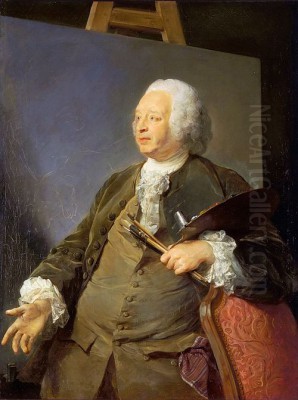
Jean-Baptiste Oudry stands as one of the most accomplished and versatile artists of the French Rococo period. Flourishing in the first half of the 18th century, Oudry (1686-1755) distinguished himself not only as a painter of animals and hunting scenes, genres for which he is perhaps best known, but also as a masterful portraitist, still life painter, landscape artist, printmaker, and influential tapestry designer. His career spanned a period of immense artistic activity in France, centered around the royal court and the vibrant cultural life of Paris. Oudry's meticulous observation, technical brilliance, and decorative sensibility earned him prestigious commissions and a lasting reputation that continues to this day.
An Artistic Heritage: Early Life and Education
Jean-Baptiste Oudry was born in Paris on March 17, 1686, into a family already immersed in the art world. His father, Jacques Oudry, was a painter and art dealer, providing young Jean-Baptiste with an early exposure to the craft and business of art. His mother, Nicole Papillon, further connected him to the artistic milieu, being the daughter of the engraver Jean-Baptiste Michel Papillon. This familial background undoubtedly nurtured his burgeoning talent and set the stage for his future career.
Recognizing his son's potential, Jacques Oudry initially provided Jean-Baptiste with foundational training. However, seeking more advanced instruction, Oudry entered the studio of the renowned portrait painter Nicolas de Largillière around 1707. Largillière, alongside his rival Hyacinthe Rigaud, was one of the most sought-after portraitists of the era, known for his rich colours and ability to capture the likeness and status of his sitters. Oudry studied under Largillière for approximately five years, until 1712, absorbing his master's techniques in portraiture but also developing skills in still life painting, a genre Largillière also practiced. Concurrently, from 1708, Oudry honed his skills at the Académie de Saint-Luc, the Parisian painters' guild, further solidifying his technical foundation.
Entering the Royal Academy and Shifting Focus
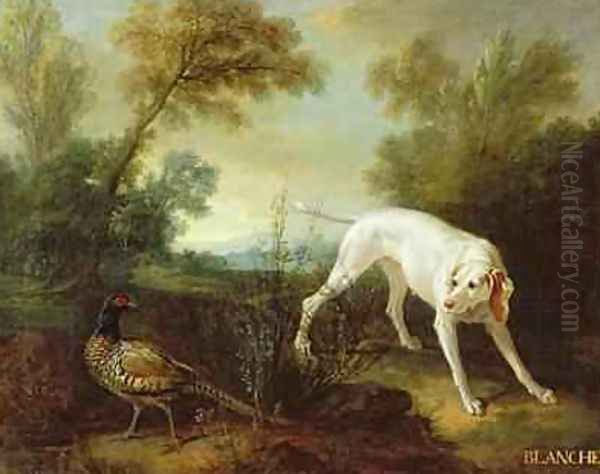
Oudry's talent quickly gained recognition within the Parisian art establishment. He became an assistant professor at the Académie de Saint-Luc in 1714 and was promoted to a full professorship in 1717. His ambition, however, extended towards the more prestigious Académie Royale de Peinture et de Sculpture (Royal Academy of Painting and Sculpture). He was accepted (agréé) as a history painter in 1717 and achieved full membership (reçu) in 1719. His reception piece, "Abundance with Her Attributes," demonstrated his skill in allegorical composition and the depiction of fruits and flowers, hinting at his future prowess in still life.
Although initially accepted as a history painter, and having produced portraits during his early career that showed the clear influence of Largillière, Oudry's true passion and greatest talents lay elsewhere. He gradually shifted his focus towards still life and, most significantly, animal painting. This transition allowed him to capitalize on his exceptional powers of observation and his ability to render textures, fur, and feathers with astonishing realism. This specialization would define his career and lead him to the highest levels of patronage.
The Premier Painter of Animals
The 18th century saw a great appreciation for animal painting, particularly scenes of the hunt, a favoured pastime of the aristocracy. While François Desportes (1661-1743) had long been the established master in this field, serving Louis XIV and the Regent, Oudry emerged as a formidable successor and, in the eyes of many, eventually surpassed his elder contemporary. Oudry brought a unique combination of meticulous detail, dynamic composition, and psychological insight to his animal subjects.
His ability to capture the individual character and vitality of animals was unparalleled. He didn't merely paint generic types; he portrayed specific creatures with their unique markings, postures, and even temperaments. This is particularly evident in his celebrated portraits of Louis XV's favourite hunting dogs. Works like "Blanche, Bitch of the Royal Hunting Pack" (1725) or the portraits of the hounds Misse and Turlu exemplify his skill. He rendered their coats with tactile realism, captured the alertness in their eyes, and placed them in naturalistic landscape settings. Oudry often studied animals from life, visiting the royal menagerie at Versailles or observing hunts directly, grounding his art in direct observation.
His hunting scenes were equally impressive, often large-scale compositions filled with energy and drama. He depicted the chase, the confrontation between hounds and quarry (stags, boars, wolves), and the triumphant return from the hunt. These works combined his skill in animal anatomy, landscape painting, and narrative composition, perfectly catering to the tastes of his aristocratic patrons, chief among them King Louis XV himself. While Desportes's work often possessed a stately, decorative quality, Oudry's frequently injected a greater sense of movement and naturalism.
Elegance in Still Life
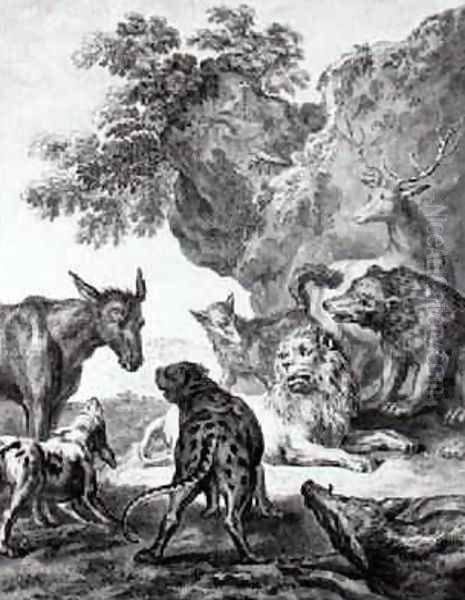
Alongside his animal paintings, Oudry excelled in the genre of still life. His training with Largillière provided a solid foundation, but Oudry developed his own distinct approach. His still lifes often feature arrangements of fruit, vegetables, dead game, fish, and luxurious objects like silver platters or porcelain vases. He was a master at rendering diverse textures – the downy skin of a peach, the iridescent scales of a fish, the soft fur of a rabbit, the reflective gleam of metal.
Oudry's still lifes drew inspiration from the rich tradition of Dutch and Flemish masters of the 17th century, such as Jan Weenix or Melchior d'Hondecoeter, particularly in the depiction of game and the richness of detail. However, Oudry infused his works with a distinctly French Rococo sensibility. His compositions are often elegant and decorative, his colours lighter and more varied, and his handling of paint smoother than that of many Northern predecessors. Works like "Still Life with Fruit and Game" or "Still Life with Fish and Parrot" showcase his ability to create visually sumptuous arrangements that appeal both to the eye and the intellect, often subtly hinting at themes of abundance, the transience of life, or the pleasures of the table. His approach differed significantly from his contemporary Jean Siméon Chardin, whose still lifes were characterized by a more austere composition, muted palette, and focus on humble domestic objects.
Favored by the King: Royal Commissions
Oudry's talent did not go unnoticed by the highest echelons of French society. His connection to the court was facilitated, in part, by friends like Jean-Baptiste Massé, a miniaturist and engraver with royal connections. Around the mid-1720s, Oudry began receiving significant commissions from King Louis XV. The king, an avid hunter, was particularly drawn to Oudry's masterful depictions of the chase and his beloved hounds.
Louis XV commissioned Oudry to paint portraits of his favourite hunting dogs, resulting in the remarkable series mentioned earlier. These were not mere animal portraits but were treated with the dignity and attention usually reserved for human sitters, reflecting the king's affection for his animals. Beyond individual portraits, Oudry was tasked with creating monumental canvases depicting the royal hunts for various royal residences, including the Château de Compiègne. These large-scale works immortalized the king's sporting pursuits and served as impressive decorations for the royal apartments. This sustained royal patronage cemented Oudry's position as one of the leading artists of his time.
Revitalizing French Tapestry: Beauvais and Gobelins
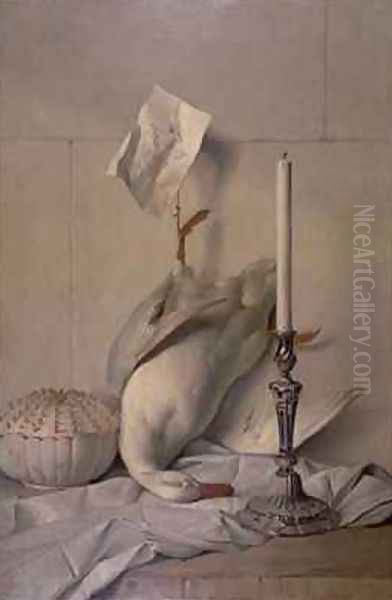
Oudry's influence extended significantly into the realm of decorative arts, particularly tapestry design. In the 18th century, tapestry remained a highly prestigious and costly art form, used to adorn the grand interiors of royal palaces and aristocratic homes. Oudry's skill in composition, his decorative sense, and his popular subject matter made him an ideal candidate to design for the royal tapestry manufactories.
Around 1726, Oudry began providing designs (cartoons) for the Beauvais manufactory. His contributions were so successful that in 1734, he was appointed co-director of the Beauvais works, alongside Nicolas Besnier. Under his artistic direction, Beauvais experienced a period of renewed success. He designed several highly popular tapestry series, including the charming "Country Amusements" (Amusements Champêtres), the theatrical "Molière’s Comedies," and, perhaps most famously, the extensive series illustrating "The Fables of La Fontaine." These designs, often featuring animals, landscapes, and scenes of rural life rendered in Oudry's characteristic style, were woven multiple times and became staples of the Beauvais production.
His success at Beauvais led to further responsibilities. In 1736, he was commissioned to design one of the most ambitious tapestry projects of the reign: "The Royal Hunts of Louis XV" (Chasses Royales de Louis XV) for the Gobelins manufactory in Paris. This prestigious series, based on Oudry's large paintings of the king's hunts, required immense skill to translate the complex compositions and subtle effects of painting into the medium of woven wool and silk. Oudry's involvement with Gobelins deepened, and in 1748, he was appointed Inspector at the Gobelins manufactory. His designs revitalized the workshops, moving away from the heavier Baroque style associated with Charles Le Brun, the influential director under Louis XIV, towards the lighter, more naturalistic, and decorative aesthetic of the Rococo.
Beyond the Canvas: Illustrations and Prints
Oudry's artistic output was not confined to painting and tapestry design. He was also a gifted draftsman and printmaker. His most notable achievement in this area was the series of 276 drawings illustrating the Fables of Jean de La Fontaine. Created between 1729 and 1734, these drawings were intended for a lavish edition that ultimately was not published in its originally conceived form during his lifetime. However, the drawings themselves were widely admired for their charm, narrative clarity, and exquisite depiction of animals.
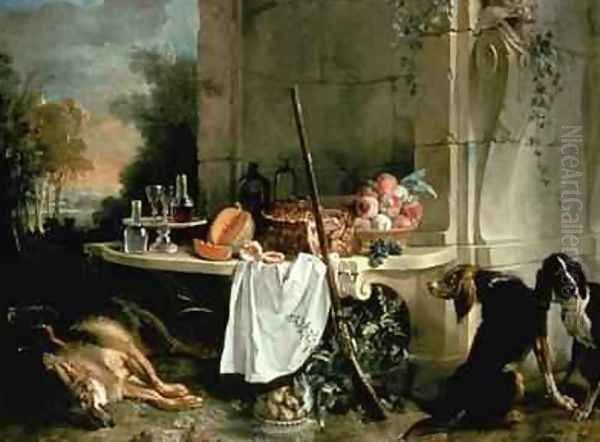
These illustrations demonstrate Oudry's deep understanding of La Fontaine's text and his ability to translate the wit and wisdom of the fables into visual form. The animals are rendered with accuracy but also imbued with expressive qualities that convey their roles in the moral tales. Many of these designs were later engraved by Charles-Nicolas Cochin and others, appearing in editions of the Fables throughout the 18th century and contributing significantly to the visual culture surrounding this literary classic. Oudry's work as an illustrator and his engagement with printmaking further underscore the breadth of his artistic talents.
An Influential Teacher and Academician
Throughout his successful career, Oudry remained actively involved in the academic art world. He took his role at the Académie Royale seriously, serving as a professor from 1734 (or possibly earlier, sources vary slightly, but certainly active in teaching by the 1730s). He was a respected teacher, and his studio attracted talented pupils. His most famous associate was arguably François Boucher (1703-1770), who, although already an established artist, worked under Oudry's direction at the Beauvais manufactory in the early 1730s, absorbing aspects of Oudry's style and approach to decorative composition.
Oudry also contributed to the theoretical discourse at the Academy. In 1749 and 1752, he delivered lectures (conférences) to the Academy members. One lecture discussed the practice of painting, focusing on aspects like colour mixing and the study from nature, while the other explored the relationship between colour and light, demonstrating his thoughtful engagement with the technical and theoretical aspects of his craft. His son, Jacques-Charles Oudry (1720-1778), also became a painter, specializing like his father in animals and still life, though he never achieved the same level of fame.
A European Reputation
While Oudry's primary patrons were the French King and aristocracy, his fame spread beyond the borders of France. His works were sought after by prominent collectors and rulers across Europe. Queen Ulrika Eleonora of Sweden acquired works by Oudry, likely facilitated by the Swedish ambassador and connoisseur Count Carl Gustaf Tessin, who was a significant collector of French art.
Another important patron was Christian Ludwig II, Duke of Mecklenburg-Schwerin in Germany, who commissioned a large number of paintings from Oudry between 1734 and 1750, primarily animal paintings, still lifes, and scenes of exotic animals, many of which remain in the collection at Schwerin Castle today. This international demand attests to Oudry's status as one of Europe's leading painters in his chosen genres during the mid-18th century. His ability to capture nature with both accuracy and elegance held broad appeal.
Oudry's Rococo Vision: Style and Context
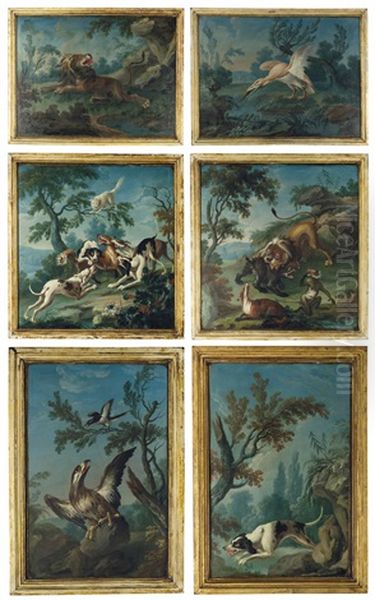
Jean-Baptiste Oudry's art is intrinsically linked to the Rococo style that dominated French art during his lifetime. His work shares the Rococo preference for elegance, lighter palettes, curvilinear forms, and themes drawn from nature, leisure, and mythology (though he focused less on the latter). His meticulous rendering of detail and texture aligns with the era's appreciation for craftsmanship and refinement.
However, Oudry maintained a strong connection to naturalism that sometimes set him apart from the more overtly decorative or fanciful tendencies of some contemporaries. Compared to the fêtes galantes of Antoine Watteau or the sensuous mythologies of François Boucher, Oudry's work often appears more grounded in direct observation, particularly his animal studies and still lifes. Yet, his compositions retain a Rococo grace and decorative quality, especially evident in his tapestry designs and larger commissioned works. He stands alongside figures like Boucher, Jean-Honoré Fragonard (representing the later Rococo), the portraitists Nicolas de Largillière, Hyacinthe Rigaud, Jean-Marc Nattier, and Maurice Quentin de La Tour, the still-life master Jean Siméon Chardin, and decorative/history painters like Charles-Joseph Natoire and Carle Van Loo as a key contributor to the diverse artistic landscape of 18th-century France.
Enduring Legacy
Jean-Baptiste Oudry died in Beauvais on April 30, 1755, while still actively involved with the tapestry manufactory there. He left behind a substantial body of work and a significant artistic legacy. He elevated the status of animal painting and still life in France through his technical mastery and the prestige of his patrons. His contributions to tapestry design revitalized the Beauvais and Gobelins manufactories, setting a standard for Rococo decorative arts.
His influence can be seen in the work of his son, Jacques-Charles Oudry, and in the decorative compositions of François Boucher. More broadly, his emphasis on careful observation from nature provided a counterpoint to purely imaginative invention within the Rococo era. His paintings, drawings, and tapestry designs remain highly prized and are held in major museums worldwide, including the Louvre in Paris, the Wallace Collection in London, the Metropolitan Museum of Art in New York, and the Staatliches Museum Schwerin. He is remembered as a versatile, technically brilliant, and immensely productive artist who captured the elegance and natural interests of his age.
Conclusion
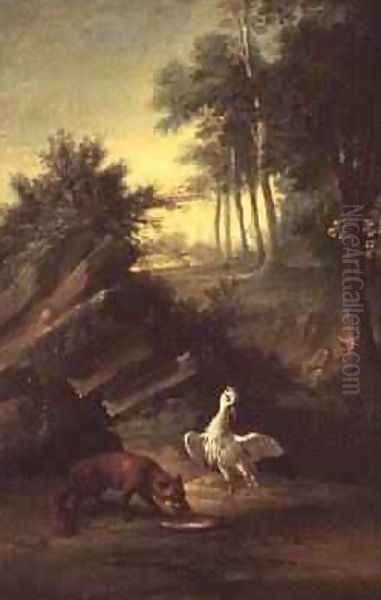
Jean-Baptiste Oudry was far more than just an "animal painter." He was a multifaceted artist who excelled across multiple genres and media. From intimate portraits of royal hounds to grand hunting scenes, from sumptuous still lifes to innovative tapestry designs and charming book illustrations, Oudry demonstrated exceptional skill and a keen eye for observation. His ability to combine meticulous realism with Rococo elegance earned him the favour of kings and collectors across Europe. His work provides a fascinating window into the artistic tastes and cultural life of 18th-century France, securing his place as a pivotal figure of the Rococo era.